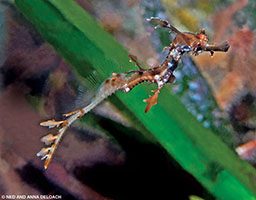The occasional kangaroo sighting notwithstanding, our drive south from Adelaide down the Yorke Peninsula on the first leg of a monthlong Australian tour brings back memories of Florida in the 1960s, when road trips and scuba diving were virtually synonymous. Fifty years later the fundamentals happily remain the same: A collective of compatible friends with an itch for adventure squeezes inside a van and sets off to see something of the world. But instead of exploring warm home waters, this time our band of five is on the hunt for the legendary sea creatures that inhabit the chilly Southern Ocean of Oz half a world away.
We make our first dives at Edithburgh, a small coastal village with a long jetty that was first built during the Victorian period to service the region’s wheat market. Today the 550-foot-long structure attracts far more divers and fishermen than farmers — and with good reason: Its underwater forest of pilings, like those of dozens of similar commercial jetties dotting the coastline from here to Sydney, is prime habitat for many of Australia’s most famous marine creatures, including seadragons.

Feeling very much like greenhorns inside brand-new neoprene drysuits, we wait our turns to leap off the jetty. Anna, first in the water, bobs to the surface, gives the OK sign and, like a pro, disappears. Inspired, I tumble in and settle onto the sand across from Anna, who is signaling wildly. As the bubbles clear I follow her finger to a black-and-white-striped pyjama squid the size of a dinner roll nestled in the grass next to her knee. Ever since we heard this animal existed we’ve wanted to see one, and in less than two minutes underwater we’re already eye-to-eye with this Southern Ocean celebrity. The little cephalopod is just the beginning. Before leaving Edithburgh we spend time with a bamboo shark, elegant cowfish, humpback boxfish, blue-ringed octopus and copious seahorses.
Flush with success, we head back to Adelaide, where we fill our tanks before turning southward once again. This time we wind though wine country on our way to the Rapid Bay Jetty, where a population of leafy seadragons has resided for years. Richard spots the first leafy, and Wendy sees another. We gather around, leaning forward, enchanted. The slow evolution of one of the most bizarre animals on Earth began some 40 million years ago when ancestors of seahorses left their holdfasts to become roving predators of mysid crustaceans. Over time they acquired the leafy features that resemble the mossy kelp gardens in which their tiny prey live.

No longer conscious of the cold, we watch the frilly, fairy-tale fish half drift, half waltz through their billowy universe. Now and again they slip into a swarm of mysids and suck them up one at a time through long-tubed beaks.
Scenery is a big part of road trips, and our route takes us along the Great Ocean Road, a two-day sightseeing extravaganza that ends with a ferry ride across the Yarra River to Portsea, a lovely coastal community 60 miles south of Melbourne. We immediately head to Flinders Jetty, where weedy seadragons, the second of the three known family members, hang out. Even in blustery conditions we find weedys — sleek, humpbacked and trailing long tails. Anna and our friend Yann think they look like kangaroos.
On our way back to the ladder Yann points toward a drifting twig, one among hundreds of similar sloshing bits of debris. Just as I begin to figure out what he’s pointing at, the twig disappears into the grass. Yann plunges in after it and, miracle of miracles, brings up a baby weedy the size of a toothpick in the palm of his hand. The short-snouted, goggle-eyed twig mimic can’t be more than a few weeks old.

Any animal that looks as unconventional as a seadragon must also have an unconventional sex life. Unlike most marine fishes, which reproduce by spontaneously releasing and leaving behind thousands of tiny eggs in the open ocean, seadragons brood their large eggs attached to the tails of males for a month. Instead of riding away with the currents, the seadragons’ large, well-nurtured hatchlings tend to remain near home, sustaining local populations.
Later in the week we fly south to Hobart in southern Tasmania, where in a golden garden of seaweed beneath towering cliffs we track down the Tasmanian rendition of the weedy. Larger than its continental counterpart (growing to 14 inches) with a red and gold bony-plated body peppered with polka dots, it’s so unusual, it’s regal. Just seeing the local weedy is worth our side trip to Hobart, but there is apparently another prized piece of evolutionary handiwork lurking in the Derwent Estuary. And we just received a tip on where to find it.
| © Alert Diver — Q3 2017 |
|---|
| © Alert Diver — Q3 2017 |